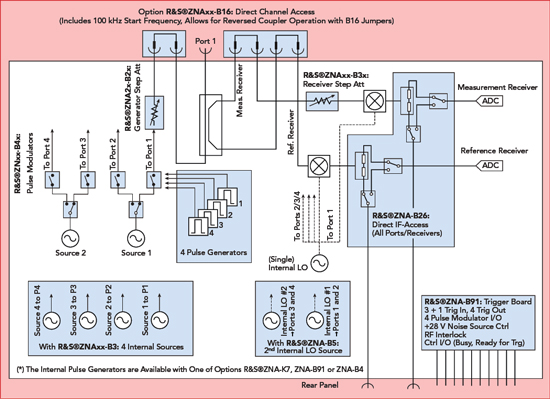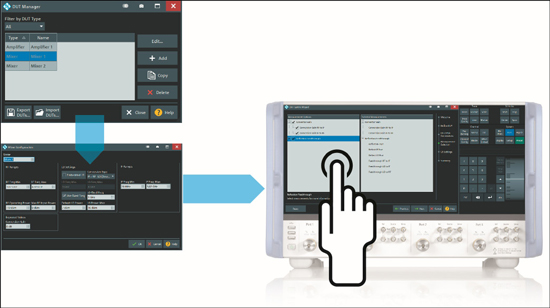
The new Rohde & Schwarz ZNA vector network analyzer (VNA) was designed to master the most challenging measurement tasks - such as component and module characterization in the aerospace & defense sector - which put strict requirements on the performance, stability, reproducibility and versatility of the VNA test platform.
For both active and passive devices, the R&S ZNA provides the flexibility required to handle the testing challenges of today and tomorrow. As shown in Figure 1, the VNA has a unique hardware architecture, offering up to four internal coherent signal sources, eight truly parallel measurement receivers and two internal local oscillators (LO). The ZNA is currently available with either 26.5 or 43.5 GHz upper frequency limit, with two or four test ports. The excellent trace noise of > 0.001 dB at 1 kHz IF bandwidth ensures accurate and highly reproducible measurements of active and passive devices.
Beyond the hardware, an intuitive and innovative operation concept, with full touch support and measurement wizards for various components, shortens test setup times.

Figure 1 Functional block diagram of the R&S ZNA.
Mixer and Amplifier Characterization
A full mixer characterization requires time to set up traces and channels with the various parameters to measure conversion loss, isolation and matching - both amplitude and phase. The new device under test (DUT) centric concept of the R&S ZNA takes this burden away from the user. After defining basic parameters like frequency range and power levels, the user selects the parameters to be measured, and the network analyzer configures the setup (see Figure 2). This capability enables the measurement to be set up quickly without in-depth knowledge of the instrument’s optimum settings, saving time and increasing reproducibility.

Figure 2 Full touch capability and measurement wizards ease test setups.
With phase-coherent synthesizers, phase and group delay measurements can be performed without additional reference mixers. The second internal LO enables the RF and IF signals to be measured simultaneously, yielding twice the measurement speed with highly accurate results.
The 100 dB electronic power sweep range makes amplifier compression point measurement an easy task, without suffering from the switching effects of step attenuators, and spectrum analysis functionality enables searching for spurious signals. The internal pulse modulators support point-in-pulse testing with up to 50x faster pulse profile testing of the DUT than before, testing often required in aerospace & defense and wireless applications.
Frequency converters without LO access, like ones used in the satellite industry, are difficult to measure due to their frequency drift. Rohde & Schwarz’s unique and patented two-tone approach enables the ZNA to measure the group delay and relative phase, even on frequency drifting converters. The measurement of both tones is performed simultaneously, thanks to the instrument’s hardware architecture, so possible drift effects of the DUT apply to both tones and are cancelled out in the measurement results. To handle drifts exceeding the instrument’s IF bandwidth, the R&S ZNA can perform an LO search sweep, and using the second internal LO doubles the measurement speed.
High Dynamic Range, Extended Frequency Range
High blocking filters used in aerospace and defense systems or base stations require the measuring equipment to have high dynamic range, both to measure very low signal levels and to use a wider IF bandwidth for the required dynamic range. Consequently, the measurement is faster and filter tuning easier. The reverse coupler mode in the R&S ZNA typically achieves a dynamic range of 170 dB (see Figure 3). To avoid saturating the measurement receivers in the filter passband, the ZNA employs a segmented sweep with different parameters for the stopband and passband.

Figure 3 The ZNA’s 170 dB dynamic range enables challenging filter measurements.
Many applications, such as on-wafer component testing, 5G mobile communications, point-to-point radio, imaging and fundamental research, use frequencies in the mmWave and THz range. Automotive radar uses 77/79 and 120 GHz has been demonstrated for short-range sensors, for example. Choosing from a range of Rohde & Schwarz frequency converters, the upper frequency coverage of the R&S ZNA can be extended. High output power and dynamic range are the key parameters of Rohde & Schwarz frequency converters, essential for on-wafer device or antenna characterization. Bypassing the input mixer stage of the VNA and using the direct IF inputs of the R&S ZNA for these measurements increases the dynamic range by some 7 dB. Up to four converters can be used with the R&S ZNA to characterize differential, multiport and frequency converting devices.
The basis for a future proof, high-end VNA is powerful hardware with excellent RF performance and functionality. Four sources, eight receivers, two LOs and other hardware components add the flexibility needed for complex measurement tasks, and the easy-to-use, DUT-centric measurement wizards simplify setup, enabling the optimal use of the instrument’s capabilities. The most challenging measurement tasks can be mastered with the R&S ZNA.
Rohde & Schwarz
Munich, Germany
www.rohde-schwarz.com
+49 89 4129 12345
